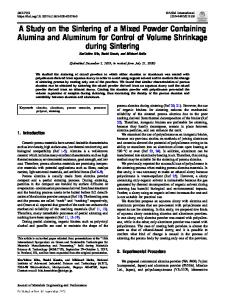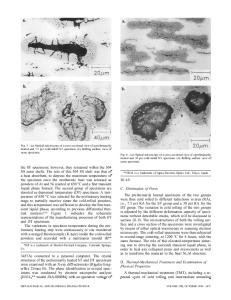Palladium sintering: Shrinkage kinetics for a sponge powder
- PDF / 1,097,170 Bytes
- 4 Pages / 612 x 792 pts (letter) Page_size
- 57 Downloads / 333 Views
HAM
P e l l e t s p r e s s e d f r o m sponge p a l l a d i u m p o w d e r w e r e s i n t e r e d both i s o t h e r m a l l y and with c o n s t a n t heating r a t e s using a p r e c i s i o n low f o r c e d i l a t o m e t e r . C o m p u t e r a n a l y s i s of the d a t a is used to d e t e r m i n e s h r i n k a g e and s h r i n k a g e r a t e b e h a v i o r d u r i n g the s i n t e r i n g o p e r a t i o n . The d a t a a r e used in conjunction with m e t a l l o g r a p h i c e x a m i n a t i o n to c o r r e l a t e the s h r i n k a g e p h e n o m e n a to the change in g r a i n s i z e and p o r e m o r p h o l o g y . The r e s u l t s show a c h a r a c t e r i s t i c s h r i n k a g e r a t e b e h a v i o r a s s o c i a t e d with g r a i n g r o w t h during s i n t e r i n g which can e f f e c t i v e l y halt d e n s i f i c a t i o n .
G
R
A
I
N
b o u n d a r i e s p l a y a s i g n i f i c a n t r o l e in the s i n t e r i n g p r o c e s s to the extent that e x t e n s i v e g r a i n g r o w t h can e f f e c t i v e l y halt s h r i n k a g e . 1,2 C o n c o m i t a n t with g r a i n growth, p o r e i s o l a t i o n o c c u r s giving r i s e to s t a b l e s t r u c t u r e s with d e n s i t i e s below that f o r wrought m a t e r i a l . 3 R e c e n t l y , it has been d e m o n s t r a t e d that the s h r i n k a g e r a t e p r o v i d e s a good m o n i t o r for the effect of g r a i n g r o w t h on the s i n t e r i n g rate.4-~ Such i n f o r m a tion has d i r e c t a p p l i c a t i o n to the study of p a l l a d i u m s i n t e r i n g k i n e t i c s . A r e c e n t study has shown p a l l a d i u m d e n s i f i c a t i o n to b e s e n s i t i v e to s i n t e r i n g c o n d i t i o n s , with the d e n s i t y following i s o t h e r m a l s i n t e r i n g p a s s i n g t h r o u g h a m a x i m u m between 800 and 1000~ 7 The i n tent of the p r e s e n t study is to d e m o n s t r a t e that such d e n s i f i c a t i o n b e h a v i o r in p a l l a d i u m is a t t r i b u t a b l e to g r a i n g r o w t h d u r i n g s i n t e r i n g and that t h i s effect can be m o n i t o r e d with p r e c i s i o n d i l a t o m e t r i c m e a s u r e m e n t s of the s h r i n k a g e r a t e d u r i n g both i s o t h e r m a l and c o n s t a n t heating r a t e e x p e r i m e n t s .
EXPERIMENTAL
APPROACH
Sponge palladium powder was selected for this study because of its fine size, high purity, and fine grain size (large grain boundary area). Although such a powder contrasts to a model system based on monosized spheres, it does approximate that used by Imm and Saeger.7 The Pd sponge, purchased from Engelhard Industries with a purity of 99.99 pct, was screened to -44 ~m. The scanning electron micrograph in Fig. 1 shows a typical sponge particle. The powder had a Fisher subsieve size of 3.5 ~im, a nitrogen adsorption specific surface area of 0.30 m2/g and a mean grain size between I and 2 pro. Unlubricated powder was compacted into 6.35
Data Loading...











